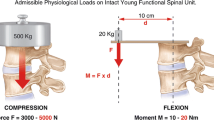Abstract
Purpose
The morphology of the alar ligaments has been inconsistently described, particularly with regard to the existence of an atlantal portion. Despite these inconsistencies, these descriptions have been used to develop physical tests for the integrity of these ligaments in patients with cervical spine problems. The purpose of this study was to describe the detailed macrostructure of the alar ligaments.
Methods
The alar ligaments of 11 cervical spine specimens from embalmed adult cadavers were examined by fine dissection. A detailed description of the macrostructure of these ligaments and their attachment sites was recorded. Measurements were performed with respect to ligament dimensions and relations with selected bony landmarks.
Results
No atlantal portion of the alar ligament was viewed in any specimen. The attachment of the ligaments on the odontoid process occurred on its lateral and posterolateral aspects, frequently below the level of the apex. The occipital attachment was on the medial surface of the occipital condyles in close proximity to the atlanto-occipital joints. The orientation of the ligaments was primarily horizontal. The presence of transverse bands extending occiput to occiput with minimal or no attachment to the odontoid process was a common variant.
Conclusions
The absence of findings with respect to the atlantal portion of the alar ligament suggests that it may be considered an anatomical variant, not an essential component for stability of the craniocervical complex. These findings may inform the use and interpretation of clinical tests for alar ligament integrity.



Similar content being viewed by others
References
Dvorak J, Panjabi MM (1987) Functional anatomy of the alar ligaments. Spine 12(2):183–189
Dvorak J, Schneider E, Saldinger P, Rahn B (1988) Biomechanics of the craniocervical region: the alar and transverse ligaments. J Orthop Res 6(3):452–461
Dvorak J, Dvorak V, Gilliar W, Schneider W, Spring H, Tritschler T (2008) Musculoskeletal manual medicine. diagnosis and treatment. Theime, Stuttgart
White AAI, Panjabi MM (1990) Clinical biomechanics of the spine, 2nd edn. J.B. Lippincott Company, Philadelphia
Aspinall W (1990) Clinical testing for the craniovertebral hypermobility syndrome. J Orthop Sports Phys Ther 12(2):47–54
Beeton K (1995) Instability in the upper cervical region; clinical presentation, radiological and clinical testing. Manip Physiother 27(1):19–32
Pettman E (1994) Stress tests of the craniovertebral joints. In: Boyling JD, Palastanga N (eds) Grieve’s modern manual therapy, the vertebral column, 2nd edn. Churchill Livingstone, Edinburgh, pp 529–537
Torres-Cueco R (2008) Aproximacion clinica a la inestabilidad craneovertebral. In: La Columna cervical: sindromes clinicos y su tratamiento manipulativo. Tomo II, vol 2. Editorial Medica Panamerica, Buenos Aires
Westerhuis P (2007) Cervical instability. In: von Piekartz HJM (ed) Craniofacial pain. neuromusculoskeletal assessment, treatment and management. Butterworth Heinemann Elsevier, Edinburgh, pp 119–147
Cave AJE (1933–1934) Anatomical notes on the occipito-atlanto-axial articulations. J Anat 68:416–423
Gardner E, Gray DJ, O’Rahilly R (1975) Anatomy. a regional study of human structure, 4th edn. W.B. Saunders Company, Philadelphia
Poirier PJ, Nicolas A, Charpy A (1911) Traite d’anatotomie humaine, 3rd edn. Massan, Paris
Cattrysse E, Barbero M, Kool P, Gagey O, Clarys JP, van Roy P (2007) 3D morphometry of the transverse and alar ligaments in the occipito-atlanto-axial complex: an in vitro analysis. Clin Anat 20:892–898
Krakenes J, Kaale BR, Rorvik J, Gilhus NE (2001) MRI assessment of normal ligamentous structures in the craniovertebral junction. Neuroradiology 43:1089–1097
Pfirrmann CWA, Binkert CA, Zanetti M, Boos N, Hodler J (2001) MR morphology of alar ligaments and occipito-atlantoaxial joints: study in 50 asymptomatic subjects. Radiology 218(1):133–137
Kim H-J, Jun B-Y, Kim WH, Cho YK, Lim MK, Suh CH (2002) MR imaging of the alar ligament: morphologic changes during axial rotation of the head in asymptomatic young adults. Skel Radiol 31(11):637–642
Zuckerman S (1961) A new system of anatomy. Oxford University Press, London
Wood Jones F (ed) (1953) Buchanan’s manual of anatomy, 8th edn. Bailliere Tindall and Cox, London
Moore KL, Dalley AFI (2006) Clinically oriented anatomy, 5th edn. Lippincot Williams Wilkins, Philadelphia
Last RJ (1978) Anatomy regional and applied, 6th edn. Churchill Livingstone, Edinburgh
Wiesel S, Kraus D, Rothman RH (1978) Atlanto-occipital hypermobility. Orthop Clin North Am 9(4):969–972
Panjabi MM, Oxland TR, Parks EH (1991) Quantitative anatomy of the cervical spine ligaments. Part 1. Upper cervical spine. J Spinal Disord 4(3):270–276
Romanes GJ (ed) (1972) Cunninghams textbook of anatomy, 11th edn. Oxford University Press, London
Panjabi M, Dvorak J, Crisco JJI, Oda T, Wang P, Grob D (1991) Effects of alar ligament transection on upper cervical spine rotation. J Orthop Res 9:584–593
Driscoll DR (1987) Anatomical and biomechanical characteristics of upper cervical ligamentous structures: a review. J Manipul Physiol Ther 10(3):107–110
Boszcyk A, Boszcyk B, Putz R, MBenjamin M, Milz S (2003) Expression of a wide range of fibrocartilage molecules at the entheses of the alar ligaments – possible antigenic targets for rheumatoid arthritis? Rheumatology 30(7):1420–1425
Fick R (1904) Hundbuch der anatomie und Mechanik der Gelenke. Verlag von Gustav Fischer, Jena
Testut L, Latarjet A (1928) Traite d’anatomie humaine, 8th edn. Doin, Paris
Ackermann MJ, Cooper MH (2005) A fresh look at the osteoligamentous structures of the cervical spine. Clin Anat 18:618
Mercer S (2004) Structure and function of the bones and joints of the cervical spine. In: Oatis CA (ed) Kinesiology. the mechanics and pathomechanics of human movement. Lippincott Williams Wilkins, Philadelphia, pp 451–469
Ludwig KS (1952) Uber das ligamentum alare dentis epistrophei des menschen. Zeitschrift fur Anatomie und Entwicklungsgeschichte 116:442–445
Okazaki K (1995) Anatomical study of the ligaments in the occipito-atlantoaxial complex. J Jpn Orthop Assoc 69:1259–1267
Boszczyk B, Littlewood A, Putz R (2012) A geometrical model of vertical translation and alar ligament tension in atlanto-axial rotation. Eur Spine J 21(8):1575–1579
Conflict of interest
None.
Author information
Authors and Affiliations
Corresponding author
Rights and permissions
About this article
Cite this article
Osmotherly, P.G., Rivett, D.A. & Mercer, S.R. Revisiting the clinical anatomy of the alar ligaments. Eur Spine J 22, 60–64 (2013). https://doi.org/10.1007/s00586-012-2496-4
Received:
Revised:
Accepted:
Published:
Issue Date:
DOI: https://doi.org/10.1007/s00586-012-2496-4




